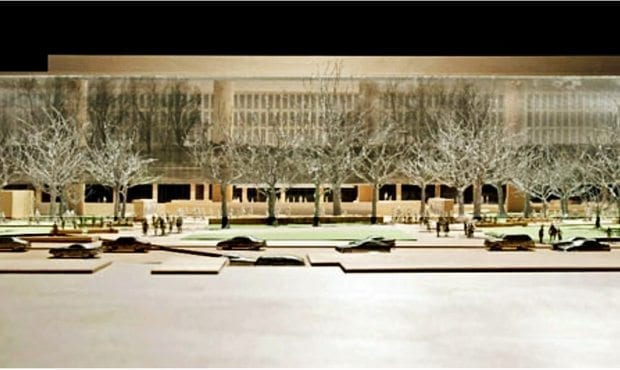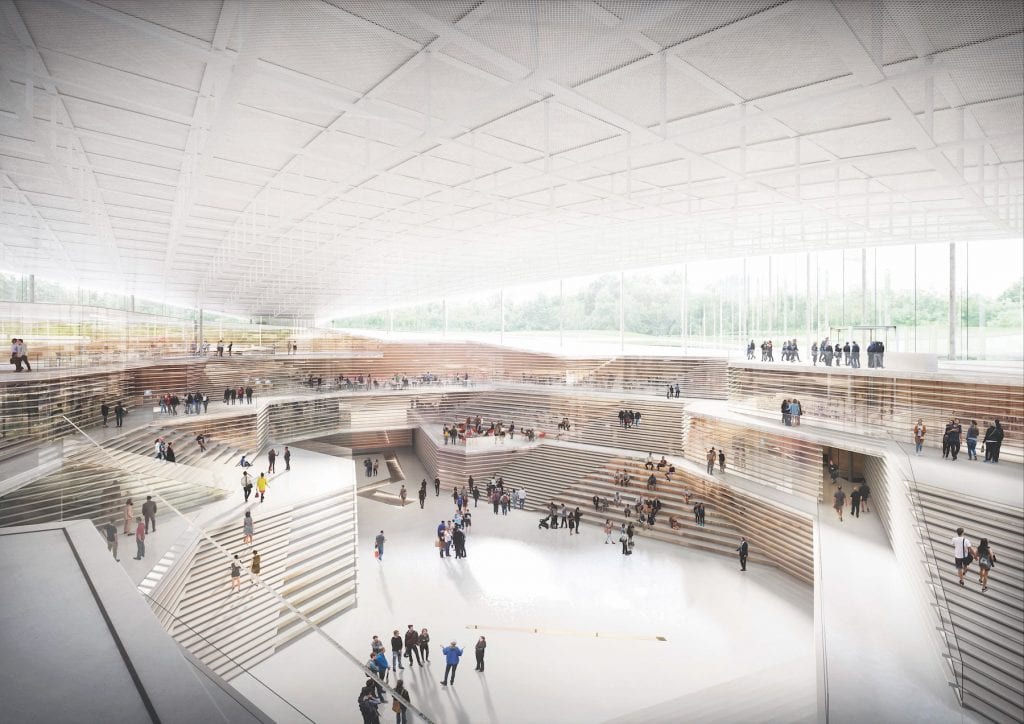A Church Ruin as Reconciliation Memorial View of winning design from south ©Heninghan Peng Architects For those tourists visiting Berlin today, the sudden approach to the ruins of a 1895 church building located on the city’s downtown Breitscheidplatz would certainly arouse their curiosity. One of the few remaining Read more…
The Cold War Veterans Memorial Competition Rendering: Oyler Wu Collaborative/Courtesy Pritzker Military Museum & Library The Pritzker family is no stranger to good architecture; so it should come as no surprise that a project launched by the Pritzker Military Archives, including a competition for a Cold War Veterans Memorial in Wisconsin, Read more…
Pedestrian perspective The result of an effort from a professor at the TUM (Technische Universität München) to restore the Budludzha Monument in Bulgaria, located in a remote location on a mountain top in that country, we discovered that it originally was the result of a 1959 design competition won by the young Read more…
The Urban Confluence Silicon Valley Competition Image ©SMAR Architecture After several stops and starts, a decision to name the winner of the Urban Confluence Design Competition appears to be nearing its conclusion. In 2017, three founders of a local non-profit established The San Jose Light Tower Corporation (SJLTC). The founders Read more…
 The Eisenhower Memorial: Sending Mixed Messages? by Stanley Collyer

Preface Since this article was written, several events have occurred which have changed our perception of the final design process. Frank Gehry went back to the drawing board and has modified his memorial design, eliminating some of the columns which we objected to at the edge of the site (January 2011, see above). One may only hope that the tapastry design element, which the Arts Commission still has some reservations about, can be resolved successfully. More recently, a group called the National Civic Art Society in Washington has issued a call for another Eisenhower Memorial competition for the same site. Apparently stuck on the idea that everything in Washington near the Mall should be in the Beaux Arts traditional style, they take offense that the Gehry design does not meet their standards of what a memorial to Ike should look like. Although probably well-meaning, this group evidently would like to turn back the clock on progress in this field. They would like to erase from memory all the advancements in new materials and ideas which have surfaced and been implemented over the past century. Is it then surprising that not one architect on their board is a national name (Most of their members are laypersons). Although their competition will undoubtedly draw some entries, it should hardly be taken seriously, much less receive any attention from the press. What they are doing is adding nothing to a positive dialogue about architecture in this country—only attempting to set it back by decades. -Ed Frank Gehry’s preferred idea for the Eisenhower Memorial was one of three proposals which the firm presented in March 2010 to the Eisenhower Memorial Commission after prevailing in the earlier selection process. Although not touted as a pure competition by the Memorial Commission, the original selection process in 2009 was typical of the General Services Administration’s Excellence in Architecture program, often used to adjudicate the design process for government projects such as federal courthouses. Read more…
Night view of the memorial tapestry from Independence Avenue, with Gehry’s sketch of the Normandy cliffs. Explaining the contributions of a World War II hero and later President of the United States on a very modest site on Independence Avenue just off the Washington Mall is tantamount to asking an author to describe Read more…
Winning entry by Coldefy & Associés (image © Coldefy & Associés) In these times when political emotions run high and gun violence is the norm, not the exception; and when emotions no longer are held in check, but encouraged by our leaders, minorities become easy targets for those who adhere to ideologies based Read more…

1st Prize Entry by querkraft architekten (Image © querkraft architekten)
Memorials to commemorate atrocities committed by the Nazis during World War II have taken many forms. Holocaust museums such as the United States Holocaust Memorial Museum in Washington, D.C. by Pei Cobb Freed or the Jewish Museum in Berlin by Daniel Libeskind, all endeavor to paint a broad picture, including narratives covering most of the major events and sites. Former concentration camps such as Auschwitz, Dachau, Theresienstadt and Buchenwald have been frequent tour destinations. In the case of Buchenwald, the local city of Weimar has placed pictures of “Witnesses” throughout the downtown area as a reminder of the Nazi legacy. Read more…
Login to see more (login problems? E: scollyer@competitions.org or http://competitions.org/contact/)
Login to see more (login problems? E: scollyer@competitions.org or http://competitions.org/contact/) |

1st Place: Zaha Hadid Architects – night view from river – Render by Negativ
Arriving to board a ferry boat or cruise ship used to be a rather mundane experience. If you had luggage, you might be able to drop it off upon boarding, assuming that the boarding operation was sophisticated enough. In any case, the arrival experience was nothing to look forward to. I recall boarding the SS United States for a trip to Europe in the late 1950s. Arriving at the pier in New York, the only thought any traveler had was to board that ocean liner as soon as possible, find one’s cabin, and start exploring. If you were in New York City and arriving early, a nearby restaurant or cafe would be your best bet while passing time before boarding. Read more… Young Architects in Competitions When Competitions and a New Generation of Ideas Elevate Architectural Quality 
by Jean-Pierre Chupin and G. Stanley Collyer
published by Potential Architecture Books, Montreal, Canada 2020
271 illustrations in color and black & white
Available in PDF and eBook formats
ISBN 9781988962047
Wwhat do the Vietnam Memorial, the St. Louis Arch, and the Sydney Opera House have in common? These world renowned landmarks were all designed by architects under the age of 40, and in each case they were selected through open competitions. At their best, design competitions can provide a singular opportunity for young and unknown architects to make their mark on the built environment and launch productive, fruitful careers. But what happens when design competitions are engineered to favor the established and experienced practitioners from the very outset? This comprehensive new book written by Jean-Pierre Chupin (Canadian Competitions Catalogue) and Stanley Collyer (COMPETITIONS) highlights for the crucial role competitions have played in fostering the careers of young architects, and makes an argument against the trend of invited competitions and RFQs. The authors take an in-depth look at past competitions won by young architects and planners, and survey the state of competitions through the world on a region by region basis. The end result is a compelling argument for an inclusive approach to conducting international design competitions. Download Young Architects in Competitions for free at the following link: https://crc.umontreal.ca/en/publications-libre-acces/ 
Helsinki Central Library, by ALA Architects (2012-2018)
The world has experienced a limited number of open competitions over the past three decades, but even with diminishing numbers, some stand out among projects in their categories that can’t be ignored for the high quality and degree of creativity they revealed. Included among those are several invited competitions that were extraordinary in their efforts to explore new avenues of institutional and museum design. Some might ask why the Vietnam Memorial is not mentioned here. Only included in our list are competitions that were covered by us, beginning in 1990 with COMPETITIONS magazine to the present day. As for what category a project under construction (Science Island), might belong to or fundraising still in progress (San Jose’s Urban Confluence or the Cold War Memorial competition, Wisconsin), we would classify the former as “built” and wait and see what happens with the latter—keeping our fingers crossed for a positive outcome. Read More… 
2023 Teaching and Innovation Farm Lab Graduate Student Honor Award by USC (aerial view)
Architecture at Zero competitions, which focus on the theme, Design Competition for Decarbonization, Equity and Resilience in California, have been supported by numerous California utilities such as Southern California Edison, PG&E, SoCAl Gas, etc., who have recognized the need for better climate solutions in that state as well as globally. Until recently, most of these competitions were based on an ideas only format, with few expectations that any of the winning designs would actually be realized. The anticipated realization of the 2022 and 2023 competitions suggests that some clients are taking these ideas seriously enough to go ahead with realization. Read more… 
RUR model perspective – ©RUR
New Kaohsiung Port and Cruise Terminal, Taiwan (2011-2020)
Reiser+Umemoto RUR Architecture PC/ Jesse Reiser – U.S.A.
with
Fei & Cheng Associates/Philip T.C. Fei – R.O.C. (Tendener)
This was probably the last international open competition result that was built in Taiwan. A later competition for the Keelung Harbor Service Building Competition, won by Neil Denari of the U.S., the result of a shortlisting procedure, was not built. The fact that the project by RUR was eventually completed—the result of the RUR/Fei & Cheng’s winning entry there—certainly goes back to the collaborative role of those to firms in winning the 2008 Taipei Pop Music Center competition, a collaboration that should not be underestimated in setting the stage for this competition Read more… 
Winning entry ©Herzog de Meuron
In visiting any museum, one might wonder what important works of art are out of view in storage, possibly not considered high profile enough to see the light of day? In Korea, an answer to this question is in the making. It can come as no surprise that museums are running out of storage space. This is not just the case with long established “western” museums, but elsewhere throughout the world as well. In Seoul, South Korea, such an issue has been addressed by planning for a new kind of storage facility, the Seouipul Open Storage Museum. The new institution will house artworks and artifacts of three major museums in Seoul: the Seoul Museum of Modern Art, the Seoul Museum of History, and the Seoul Museum of Craft Art.
Read more… |




































